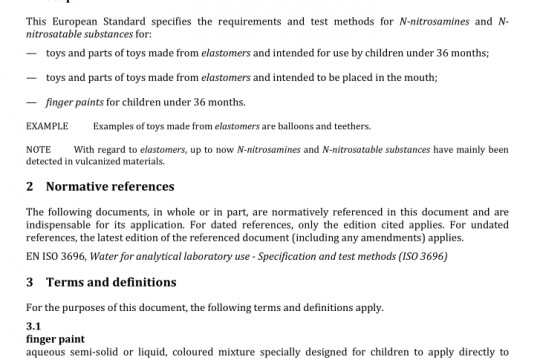BS EN 205 pdf free download
BS EN 205-2016 pdf free download.Adhesives — Wood adhesives for non-structural applications — Determination of tensile shear strength of lap joints.
4 Principle A symmetrical bonded single lap joint between two symmetrical wooden adherends is subjected to specified conditioning treatments and strained to rupture by a tensile force parallel to the grain.
5 Apparatus The testing machine shall be a constant-rate-of-traverse machine as described in ISO 5893.
If a constant-rate-of-traverse machine is not available, a constant-rate-of-loading machine shall be used causing a rupture within the time limits specified in 6.5.
The jaws shall grip the test pieces with a wedge action and permit self-alignment while the test pieces are being pulled.
6 Procedure
6.1 Preparation of bonded assemblies Prepare two panels (see Figure 1) from a thick unsteamed, conditioned, straight-grained board of beech (Fagus sylvatica L.) with a nominal density of (700 ± 50) kg/m3 with a moisture content of (12 ± 1) %.
It is permissible to prepare panels from different boards unless it is essential to minimize differences in the wood in order to conduct special comparative tests. Ensure that the angle between the growth rings and the surface to be bonded is between 30° and 90°. Cut the panels across the direction of the grain to a length equal to a multiple of 300 mm with the necessary allowance for cross-cutting and along the grain to a width of approximately 130 mm making an allowance for the width of cut as shown in Figure 1. For tests use two panels of (5,0 ± 0,1) mm thickness. For conventional tests, condition the panels at a temperature of either (20 ± 2) °C and (65 ± 5) % relative humidity or (23 ± 2) °C and (50 ± 5) % relative humidity subsequently referred to as the standard atmosphere (20/65) or (23/50) for a minimum of 7 days. Prepare bonded assemblies using thin (approximately 0,1 mm) bond-lines. Not more than 24 h before bonding, either lightly plane or lightly sand each surface to be bonded (using an abrasive paper of grain size P100 complying with ISO 6344-2:1998 is recommended). Remove any dust carefully. Do not touch or soil the prepared surfaces. Comply with the adhesive manufacturer’s instructions regarding the processing conditions, including the preparation of the adhesive, the amount of adhesive to be applied, whether the adhesive is to be applied on one or both surfaces, the open and closed assembly time and the magnitude and duration of the assembly pressure and report them in the test report.
Where no manufacturer’s instructions are available the following processing conditions shall be used:
— adhesive applied on both sides;
— adhesive spread: (150 ± 10) g/m 2 ;
— open assembly time: (120 ± 10) s;
— closed assembly time (180 ± 10) s;
— pressing pressure (0,7 ± 0,1) N/mm 2 ;
— pressing time: 2 h;
Bond the two 5 mm thick panels as shown in Figure 1 with the pressure uniformly distributed over the bonded surface.
6.2 Preparation of test pieces After pressing condition the assembly for 7 days in standard atmosphere. A longer conditioning time may be used if recommended by the adhesive manufacturer. The test pieces shall not be cut earlier than 5 days after bonding. Cut five strips of width b = (20 ± 0,2) mm from each bonded assembly along the grain, avoiding areas within 7,5 mm of the outside long edges of the panel as shown in Figure 1. Cut these strips into test pieces of length l 1 = (150 ± 5) mm as shown in Figure 2. Make flat bottomed cuts of (2,5 ± 0,5) mm wide in the bonded sections across the grain so that an overlap of length l 2 = (10,0 ± 0,2) mm is defined in the middle section (see Figure 2). The cuts are to separate the wood layers. Take care that the cuts completely cut through the bond line but only penetrate as little as possible into the other part of the joint.BS EN 205 pdf download.




